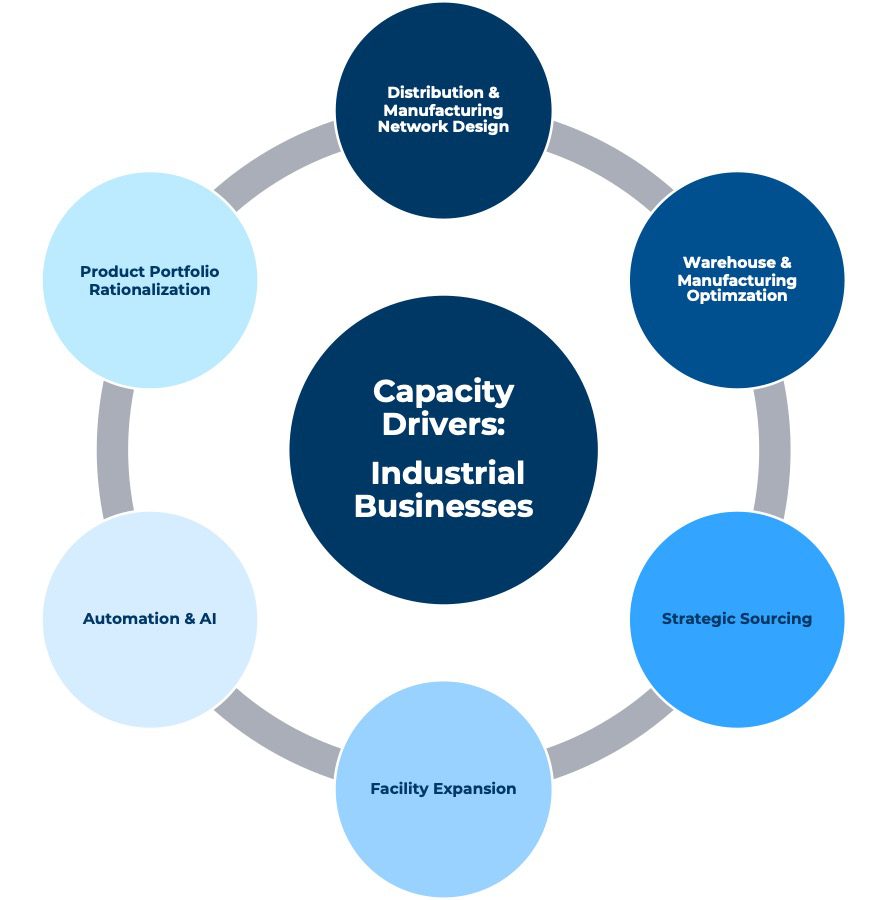In today’s landscape, businesses across industries face the daunting challenge of scaling operations to meet escalating demand. The journey towards sustained growth is often hindered by a complex array of capacity constraints. This article, initiating a comprehensive series, aims to delve into the art and science of optimizing capacity across the value chain—a pivotal endeavor for any organization striving for growth and enhanced market competitiveness.
Understanding the Capacity Challenge
Capacity challenges in rapidly growing companies can stem from a myriad of sources: misaligned Sales, Inventory, and Operations Planning (SIOP), outdated network designs, inadequate facility space, underutilized automation, inefficient warehousing strategies, unoptimized product portfolios, and ineffective strategic sourcing. Addressing these issues requires a comprehensive approach, integrating improvements across all operational facets to unlock the full potential of the business.

Comprehensive Capacity Expansion Planning
Assessing Current Capacity
The first step in planning for capacity expansion is a thorough assessment of current operations. This involves:
Conducting a Capacity Audit: Evaluate existing processes, machinery, workforce, and technologies to identify bottlenecks and inefficiencies.
Analyzing Demand Forecasts: Use historical sales data and market analysis to predict future demand and understand the capacity required to meet these projections.
Strategic Planning for Capacity Expansion
After assessing the current state, companies must strategize on several fronts to ensure holistic capacity expansion:
- Maximizing Capacity with Lean Principals / Optimizing Current Operations: Lean principles offer a powerful approach to maximizing capacity without the need for significant new investments in space or equipment. By focusing on eliminating waste, improving process efficiency, and enhancing value to the customer, businesses can unlock new levels of productivity within their current operations.
- Developing a SIOP Process: Enhance coordination between sales, production, and inventory management to align with market demand, improving both efficiency and customer satisfaction.
- Redesigning the Network: Optimize the location and capabilities of production facilities and distribution centers to minimize costs and delivery times.
- Facility Expansion and Optimization: Consider expanding existing facilities or optimizing layout and processes to increase production capacity without necessarily increasing footprint.
- Investing in Automation: Evaluate areas where automation can significantly boost production efficiency and reduce dependency on manual labor.
- Warehouse Optimization: Implement advanced warehousing solutions and practices to maximize storage efficiency and streamline operations.
- Product Portfolio Rationalization: Focus on high-margin, high-demand products to maximize returns on investment and reduce complexity.
- Enhancing Strategic Sourcing: Build resilient supply chains through diversified sourcing strategies and strong supplier relationships to ensure material availability and cost-effectiveness.
Implementing Cross-Functional Collaboration
A critical aspect of capacity planning is fostering cross-functional collaboration. Integrating efforts across departments ensures that capacity expansion strategies are aligned with overall business objectives and market demands. This can involve forming dedicated project teams, regular cross-departmental meetings, and shared performance metrics to monitor progress and adjust strategies as needed.
Leveraging Technology and Data Analytics
Technology plays a pivotal role in capacity planning and expansion. Utilizing ERP systems, data analytics, and AI can provide insights into operational efficiencies, demand forecasting, and market trends. These tools help businesses make informed decisions about where to invest in capacity expansion and how to optimize existing resources.
Conclusion
As the gateway to a series focused on unlocking capacity for growth, this article highlights the necessity of a comprehensive approach to capacity expansion. By assessing current operations, strategically planning for expansion, fostering cross-functional collaboration, and leveraging technology, middle market businesses can position themselves to meet demand and sustain growth. Stay tuned for our upcoming articles, where we’ll explore each of these areas in detail, offering insights and actionable strategies to optimize capacity across the value chain.
